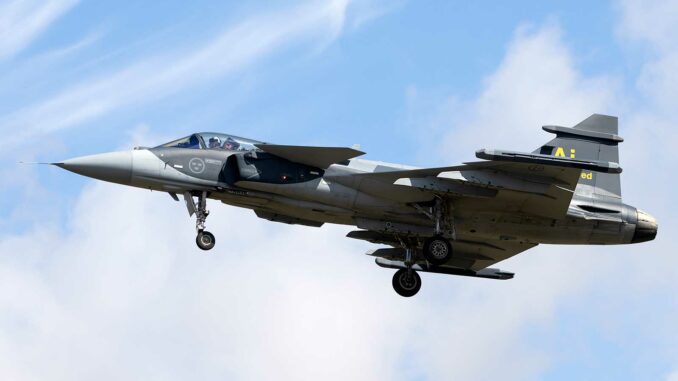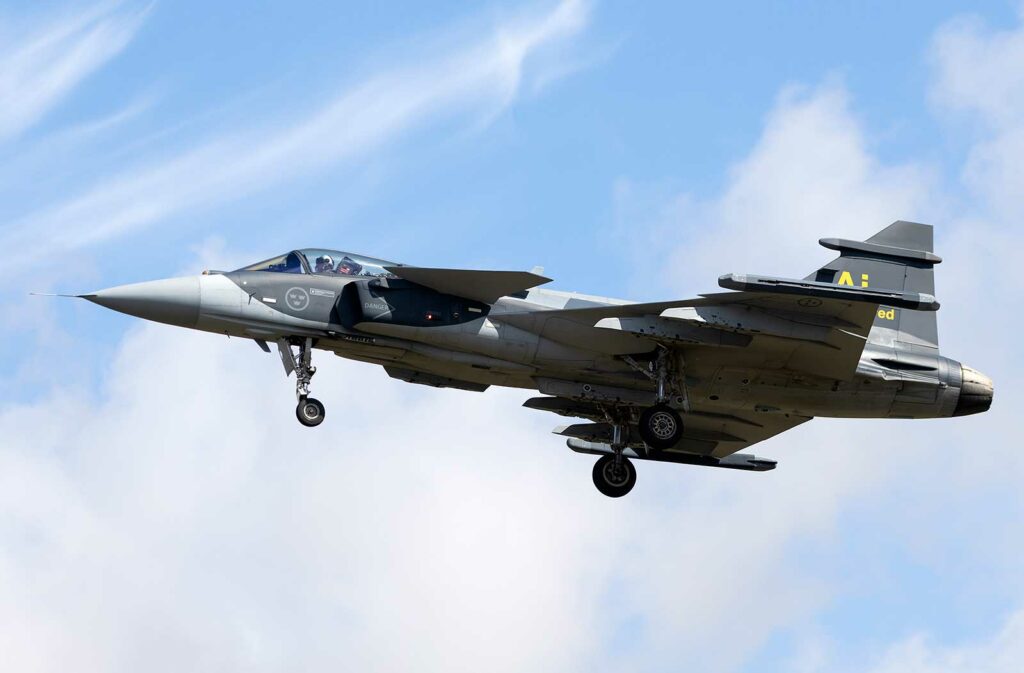
Sweden and Ukraine sign a letter of intent for the delivery of up to 150 Gripen E fighter jets. A major turning point, but many challenges remain.
In summary
On October 22, 2025, in Linköping, Sweden, Swedish Prime Minister Ulf Kristersson and Ukrainian President Volodymyr Zelenskyy signed a letter of intent (LOI) for the possible sale of 100 to 150 Saab JAS 39 Gripen E multirole fighters to the Ukrainian Air Force. This potential contract would mark Ukraine’s first major acquisition of new aircraft since its independence in 1991. The Gripen was chosen for its rapid maintenance, its ability to operate from rudimentary runways, and its lower cost compared to 5th generation fighters. However, no firm timetable or financing plan has yet been established, and numerous technical, logistical, and budgetary challenges remain. The challenge for Kyiv is to rebuild a modern air force capable of gradually replacing its inherited Russian fleets. This first Swedish-Ukrainian step opens a new era for Ukrainian air defense in the context of a prolonged war.
The context and motivations behind the choice of Gripen
Ukraine has been engaged in a prolonged conflict since the Russian invasion of 2022. Until now, its air force has relied heavily on Soviet-era aircraft—such as the MiG-29 and Su-27—for which parts, maintenance, and ammunition are becoming increasingly difficult to obtain. The need for a versatile Western fighter capable of operating in a contested environment has become apparent. The Gripen E, a modernized version of the Gripen family, is being proposed as a pragmatic solution: equipped with Geared Turbofan engines, AESA radar, and enhanced electronic warfare capabilities, it appears well suited to the requirements of the Ukrainian theater. According to several sources, the unit cost is estimated at around $85 million in certain scenarios.
The choice of Gripen is also tactical: it can operate from short runways—even roads—which is crucial for Ukraine, whose bases are often threatened by enemy missiles or drones. This would allow the aircraft to reduce its vulnerability on the ground by operating in a dispersed manner. Through this cooperation, Sweden is seeking to strengthen not only its ties with Ukraine, but also its own arms industry (Saab AB) and its place within the enlarged NATO.
The content of the letter of intent and the broad outlines of the agreement
At the signing, Kristersson clarified that the LOI is not a binding contract but a first step toward a full-scale agreement. The figure mentioned is a range of 100 to 150 aircraft. The agreement provides for broader air cooperation between the two nations, including exchanges of experience and training. The press release states that Ukraine “will benefit from unique air combat experience” and that Sweden “will contribute to the development of a future modern Ukrainian air force.”
Regarding the timeline, Zelenskyy expressed hope that deliveries would begin as early as 2026, but several observers warn that this remains optimistic. Financing remains unclear: some suggest using frozen Russian assets or a “coalition of the willing” among Western allies to share the cost.
Integrating the Gripen into the Ukrainian Air Force: challenges and scenarios
Ukraine is now considering integrating a fleet of Western fighter jets alongside its first F-16s and Mirages 2000. The Gripen would be a central element of this transition. However, several challenges remain:
Standardization and compatibility
Ukraine will have to absorb not only the aircraft but also the entire ecosystem: maintenance, logistics, spare parts, ammunition, pilot and technician training. The Gripen E represents a very different generation from Ukraine’s older aircraft. The transition will require a considerable effort.
Infrastructure and training
To operate the Gripen effectively, modernized infrastructure is needed: suitable runways, refueling systems, simulators, and crew training. The fact that the aircraft can use road strips is an advantage, but this alone is not enough to guarantee optimal operation.
Delivery and transition phases
A plausible scenario: initial deliveries of slightly used aircraft or older Gripen C/D models while awaiting the new E batches. The document indicates that the agreement could span 10 to 15 years. Ukraine will therefore have to manage this transition period while continuing to conduct ongoing operations.
Total cost and financing
At approximately $85 million per unit for the E model, the purchase of 100 to 150 aircraft would represent a commitment of $8.5 to $12.8 billion, not including associated systems, training, and logistical support. Financing could come from frozen Russian assets, international aid, or European mechanisms.
Integration into Ukrainian operational doctrine
Operational immediacy requires that a certain number of aircraft be delivered quickly. The Gripen, with its ability to operate from improvised bases, fits in with Ukraine’s doctrine of resilience and dispersion. However, Ukraine will need to align its tactics, ammunition, and doctrines with those of the Swedish manufacturer and its allies.
Why this number (100-150) and what are the strategic implications?
The scale of the order—up to 150 aircraft—is remarkable: it is the largest Gripen export ever considered. This quantity would enable Ukraine to form a strategic core of modern fighters, multiplying the density and resilience of its air force. With 100 aircraft, Ukraine would have a larger fleet than it currently has (a few dozen MiG-29s and others).
Strategically, this would strengthen Kyiv’s position vis-à-vis Russia: increased air superiority, more effective strikes, and enhanced deterrence. For Sweden, this means a stronger position within NATO, credible support for Ukraine, and a major contract for Saab. For the European defense industry, it is one of the largest fighter jet programs in Europe in a long time.

Remaining challenges: timeline, financing, production
Several obstacles remain:
Timeline: No firm commitment on the first deliveries. The order could be spread over 10 to 15 years. The speed of delivery depends on Saab’s production capacity (estimated at around 20 to 30 aircraft per year) and the priority given to this contract.
Financing: Although the idea of using frozen Russian assets has been raised, implementation remains complex. The overall contract could require tens of billions of euros.
Production and industrialization: Saab must increase its production rate, guarantee supplies, assembly lines, and the delivery of associated systems (radars, electronics, logistics).
Training and operational framework: Ukrainian pilots, technicians, and infrastructure must be prepared. Tests have already been conducted in Sweden.
Compatibility with the theater and the ongoing war: Ukraine is still engaged in conflict. The commissioning of new platforms must be accompanied by a seamless transition in capacity.
Industrial interest for Saab and the European sector
For Saab, this potential contract is significant: never before has an operator ordered such a large number of Gripen aircraft. The market for 100 to 150 aircraft represents a qualitative and quantitative leap forward. For Europe, it strengthens the defense industry in the face of American and Russian competition. For Ukraine, it signals that the country can now become a front-line customer for Western combat technologies, and not just a recipient of aid.
Why now, and what is the political symbolism?
The timing of this announcement comes at a politically significant moment: Ukraine is seeking to secure its long-term future vis-à-vis Russia, while Sweden wants to assert its role in European defense and transatlantic cooperation. The fact that the announcement was made in Linköping, the Gripen production facility, between the two heads of state, underscores the political as well as the military dimension. It sends a clear message: Ukraine is resolutely turning to the West, and modernizing its air force is a priority.
Impacts for the Ukrainian Air Force and its adversaries
On the ground, the possible arrival of the Gripen could change the dynamics: increased patrol, interception, and strike capabilities, and improved aircraft survivability thanks to the doctrine of dispersion. For its Russian adversary, this means that Kyiv could increase its ability to harass logistics, protect its airfields, and challenge air superiority.
For Ukraine, the challenge is to avoid exclusive dependence on a single type of aircraft or a single supplier. It will need to maintain its existing aircraft, introduce new ones, and ensure diversification: the Gripen will join the F-16s and Mirages.
A strategic step towards air force reconstruction
This letter of intent for 100 to 150 Gripen E aircraft marks a major step for the Ukrainian Air Force. It reflects a lofty ambition: to have a modern fleet that is compatible or aligned with the West and capable of engaging in high-intensity conflict. But it does not yet resolve the fundamental issues: financing, a realistic timetable, production, operational integration, and logistics.
There is still a long way to go—10 to 15 years are mentioned for full implementation. But what is now clear is that Ukraine plans to make a clean break from its Soviet aircraft and embark on a path of Western modernization. The Gripen could become the cornerstone of this new Ukrainian air force, provided that all the links in the chain—industry, training, finance, infrastructure—fall into place without friction.
War Wings Daily is an independant magazine.